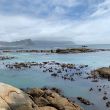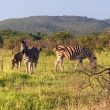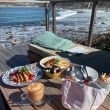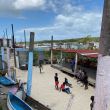Dear ITG,
The best time to visit Cape Town, South Africa is right about now—when the midday marigold sun warms your skin but doesn’t boil your sweat. The climate gets more tropical if you were to travel a few hundred miles northeast, where giants of the animal kingdom roam the national state park, Kruger. There, it’s a hell of a lot hotter, and the humidity sits on your shoulders like a microwaved damp towel. But the evenings aren’t that bad—they’re downright cool and punctuated by hundreds of stars in the night sky. So I guess the best time to visit that part of the country is now, too.
My honeymoon brought me to South Africa for two weeks; I just got back a few days ago. I was totally clueless when it came to planning my wedding, but the honeymoon? Oh, I knew. It had to be South Africa, where everyone I knew who had gone before came back home for the better, grateful for the experience. So, one fifteen-hour flight later (where I subjected myself to multiple forms of moisturization, per aesthetician Sofie Pavitt’s instructions), I made my very first trip to Africa, to the southern hemisphere, where I got straight to the important stuff: the toilets. Did you know they really don’t flush counterclockwise down there? (Another schoolyard urban legend strikes again.)
Anywho, Cape Town is flanked by the Atlantic Ocean on the west and Table Mountain in the east, whose sedimentary rock lords over the city and predates The Himalayas six times over. Our first few days were a heavy education of South African history and culture. A recommendation from Leah led us to the District Six Museum. In it, a brutal history of the neighborhood: over 60,000 non-white South Africans were forcibly removed from their homes throughout the ‘60s and ‘70s, after the government declared it to be a “whites only” zone. If you were Black you could still go there for work, so long as you carried a pass permitting your entry. In travel, when you’re stepping into an unknown world, there’s a natural tendency to reflect on the common denominators—the connective tissue that can take shape in a shared love of foods, music, pets, what have you. I found so many of those in Cape Town. Places like District Six remind us that the stain of inhumanity is what can connect us, too.
On another day we headed to Cape Town’s Museum of Contemporary Art for a retrospective of South Africa native William Kentridge’s sharp, political drawings and animations. And after that, just down the museum steps and past the sleeping seals on the harbor, was the ferry that took us to Robben Island and the prison that held Nelson Mandela for 18 years. Our tour guide was a former inmate. Like Mandela, his great crime was membership in an opposing political party. Several of his friends were jailed with him—one was beaten to death in police custody—and shortly after arriving at Robben Island, his lawyer was murdered, too. He recalled his daily life there with resolved clarity. There was a limestone quarry on the island where all day long, prisoners were tasked with chipping away at the earth—an activity with no other purpose than explicit punishment. He said on a clear day you could make out Cape Town’s sandy shoreline in the distance. But when we went it was rainy and gray, and all I could see was murk.
The next day was maybe my favorite. We went on a bike tour with a company called ABCD Concepts in Khayelitsha, which is a township just outside of Cape Town. Its inhabitants are mostly made up of the Xhosa-speaking members of South Africa’s indigenous population. Up until the early 1990s it was illegal for Black Africans to live within Cape Town city limits, and Khayelitsha was the outcome of that state-sanctioned segregation. “Informal homes”—houses made of thin scrap metal—constitute about 30-percent of the dwellings. We picked up smoothies at The Spinach King and ate at 4Roomed Ekasi for a traditional lunch. And then we walked up the street to Rands, an outdoor club, for hours of afrobeats music. “I never want to leave!” I told my husband, prematurely. An hour later the sun beat me out, and nothing sounded better than a bottle of water and a cool bed.
Days later we drove down the coast via Chapman’s Peak, which is South Africa’s version of Highway 101, but with penguins. It’s cooler and breezier there. By this time I had fully settled into my South African beauty routine, which made the drive’s early call time a lot easier to be punctual for. The sun was deceptively cool, and I hadn’t noticed that I was developing an epic tan until a week into the trip. So with that, I cut off my P50 (the acids were making my skin more sun-sensitive) and doubled down on SPF with hourly re-applications. I put on a little concealer here and there, a dab of cream blush and a lip oil, and that was it. Simplicity was the name of the game here.
We went on a safari in the northeast for the last leg of the trip. Having never done a thing like that before, I assumed we’d see a handful of animals at most, if we got lucky. But even as our plane taxi-ed down down the runway we were met with an audience of zebras and a few giraffes. In the days that followed we saw lions, cheetahs, elephants, hippos, rhinos, monkeys, and impalas. We tracked a leopard by following the drag marks of its kill, a large warthog. Pinpointing these animals within a 100-square mile game reserve turned out not to be that difficult, at least for our genius tracker and guide. Under the callous chorus of nature is a straightforward rhythm. The bark of an impala after it spots a predator; the sunrise hippo march that always ends at a watering hole, where they can keep cool for the day; the buffalos sleeping where they also eat in open pasture. Creatures of nature and also of habit, with their own morning and nighttime routines.
—Ashley Weatherford
Photos via the author.




























